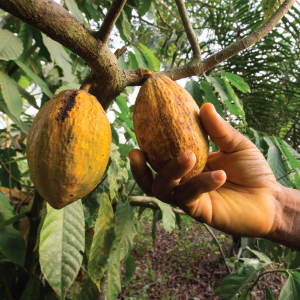
Valentine’s Day is Friday and as everyone runs to purchase chocolate to showcase their love for a significant (or themselves), the world is rushing to save the cacao plant.
Business Insider estimated that the natural source of chocolate, cacao plants, may go extinct by 2050. It’s a particular plant with a particular growing pattern. All cacao plants are grown within a narrow strip of rainforest land that sits 20 degrees north and south of the equator. In this environment, rain and humidity are consistent throughout the year, making it the ideal conditions for cacao to thrive – including half of the world’s chocolate from Côte d’Ivoire and Ghana.
As temperatures increase in the next decades without rainfall to offset the moisture loss, cacao fields will be forced to move higher into the mountains. However, this vital land has already been preserved for wildlife, according to the National Oceanic and Atmospheric Administration.
This concern is not new to the chocolate giants like Mars, which is a $35 billion corporation that produces Snickers. Business Insider reports that in September 2017, Mars pledged $1 billion in effort of “Sustainability in a Generation.” This movement will focus on reducing their carbon footprint by more than 60% by 2050, and includes a collaboration with Dr. Jennifer Doudna of Japan.
In preparation of limited chocolate and vital food sources, the geneticist, Dr. Jennifer Doudna invented CRISPR, a powerful tool for editing genomes. Live Science, explains that allows researchers to alter DNA sequences and modify gene functions to grow and produce food in unnatural environments. Working towards production of food for vulnerable communities around the world, in addition to the cacao plant.
Unfortunately, there are not always easy tips to fix a problem. In this case, how we buy, how we live, and who we support affects the future of consumption—including other threatened commodities such as beer, avocados and coffee.
This is a bigger problem that relies on all of us. Forgo single use plastics, vote for climate change focused leaders, support sustainable business, be a smart consumer and work towards a chocolate filled, glorious future. For more ways to support sustainability locally, visit: walkingmountains.org/sustainability.
Mackenzie Koffenberger, lover of chocolate, is the Marketing and Communications Coordinator at Walking Mountains Science Center. She can be reached at mackenziek@walkingmountains.org
https://www.businessinsider.com/when-chocolate-extinct-2017-12?utm_source=feedly&utm_medium=webfeeds
https://www.climate.gov/news-features/climate-and/climate-chocolate
https://www.rainforest-alliance.org/article/preparing-cocoa-farmers-for-climate-change








